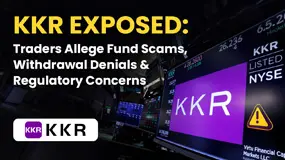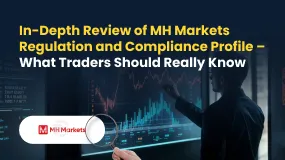简体中文
繁體中文
English
Pусский
日本語
ภาษาไทย
Tiếng Việt
Bahasa Indonesia
Español
हिन्दी
Filippiiniläinen
Français
Deutsch
Português
Türkçe
한국어
العربية
What Is Margin in Forex Trading?
Abstract:In forex trading, margin refers to the funds that investors need to pre-deposit in their trading accounts to engage in leveraged trading.

Understanding and effectively utilizing margin are crucial keys to success for investors participating in the forex market. Margin serves as a leverage tool, allowing traders to control larger positions with relatively small capital, providing them with flexibility and more trading opportunities. This article delves into what margin is in forex trading, its role in the trading process, and how it is calculated. Finally, as you explore the numerous advantages of margin trading, it is essential not to overlook the associated risks. Are you ready? Continue reading to find the answers!
Definition of Margin in Forex Trading
In forex trading, margin refers to the funds that investors need to pre-deposit in their trading accounts to engage in leveraged trading. Leverage allows investors to control larger positions with relatively small capital. Margin is the amount frozen by traders to cover potential losses, ensuring they have enough funds to support their positions while also helping to mitigate potential default risks.

In practical terms, margin is typically expressed as a percentage, depending on the leverage ratio. This ratio may vary among brokerage firms. For instance, if a broker allows a maximum leverage ratio of 50:1, investors may only need to provide 2% of the total position value as margin. The remaining 98% of the funds are provided by the broker. This enables investors to control larger positions with only a small amount of margin – a unique advantage in the forex market.
It's important to note that margin is not a fee paid to the broker or other parties involved in the trade. Instead, it is the investor's own funds temporarily frozen to serve as collateral during the transaction.
How to Calculate Forex Margin
Calculating margin in forex involves two key concepts: initial margin and maintenance margin. Both are funds required during forex trading to ensure there is enough capital to support positions and prevent potential losses.
Initial Margin Calculation

The initial margin is the amount required to be paid when opening a position. The calculation is as follows:
Initial Margin=Position Size/Leverage Ratio
Position Size represents the quantity of the currency pair you intend to trade.
Leverage Ratio is the leverage level you have chosen, typically expressed as a ratio like 50:1 or 100:1.
For example, if you wish to trade €100,000 of EUR/USD with a leverage of 50:1, the initial margin calculation would be:
Initial Margin=100,000/50=2,000 USD
Therefore, you would need to pay $2,000 as the initial margin into your trading account.
Additionally, due to increased liquidity risk, some brokers may require higher margins for weekend positions. If the regular margin during the week is 2%, the weekend margin may increase to 3% or 4%.
Maintenance Margin Calculation

Maintenance margin is the minimum capital required to sustain a position. When market fluctuations lead to losses approaching or reaching the initial margin level, a margin call may occur. The calculation for maintenance margin is as follows:
Maintenance Margin=Position Size×Current Market Price/Leverage Ratio
Position Size denotes the quantity of the currency pair currently held.
Current Market Price is the current market value of the currency pair.
Leverage Ratio remains the leverage level you have chosen.
If the maintenance margin falls to or below this level, it may trigger a margin call.
Please note that different brokers may have varying regulations and calculation methods. Therefore, before engaging in actual trading, it is advisable to review the trading rules and margin requirements of the broker you have chosen.
Explanation of Forex Additional Margin Notice
A Forex additional margin notice refers to a notification issued by a broker to a trader when the funds in the trader's account are insufficient to support their positions. This notice requires the trader to add more funds to maintain their positions and ensure there is enough margin to withstand market fluctuations.

Here are some important explanations and aspects regarding Forex additional margin notices:
Insufficient Margin
Typically, an additional margin notice is issued when the margin level in the account falls to or below a certain percentage of the initial margin. This may occur due to market fluctuations leading to losses, causing the available funds in the account to no longer adequately support the positions.
Notification Content
Such notifications usually include the current status of the account, specific reasons for the losses, the exact amount that needs to be added, and the deadline for adding funds. The purpose of the notification is to inform the trader about the account's condition and prompt them to take appropriate actions.
Deadline for Additional Funds
The notification often specifies a deadline, requiring the trader to add sufficient funds by that date. Failure to add funds within the specified timeframe may lead the broker to take measures such as forced liquidation of positions.
Risk Management
Upon receiving an additional margin notice, traders need to carefully consider market conditions, account risks, and whether they have the capacity to add the required funds. Implementing a sound risk management strategy is crucial to ensure traders can appropriately respond to market volatility.
Preventive Measures
To avoid receiving additional margin notices, traders can take preventive measures such as setting reasonable stop-loss levels, selecting leverage ratios prudently, and adhering to risk management strategies.
Negative Balance Protection

Sometimes, stop-loss orders or additional margins may not be sufficient for traders to avoid excessive losses. This situation occurs when the market lacks liquidity or experiences rapid price fluctuations, gaps, and slippage.
Many brokers offer negative balance protection – a service mandatory for all brokers regulated within the European Union. This protection provides reassurance to traders during periods of high volatility and trading volume, ensuring that retail traders do not face negative balances or owe more money than they initially deposited.
History has taught us a costly lesson – the financial earthquake in Switzerland. On January 15, 2015, the Swiss National Bank (SNB) decided to abandon the minimum exchange rate of 1.20 for the Euro against the Swiss Franc, leading to a flash crash of the Swiss Franc.
On that day, the Euro/Swiss Franc currency pair plummeted by 40% in just a few minutes, forcing FXCM's clients to endure over 225 million USD in negative balances.
Risks of Forex Margin Trading

As outlined in the preceding text, Forex margin trading involves leverage, enabling traders to control larger positions with relatively small capital. However, corresponding to the potential returns, there are inherent risks.
Market Volatility Risk
Normal fluctuations in forex market prices are magnified by leverage, impacting the trader's capital. While leverage can amplify profits, it can also lead to substantial losses. Sudden market volatility can swiftly expose traders to significant potential losses.
Margin Call Risk
If market fluctuations result in losses exceeding the initial margin, brokers may issue margin call notifications, requiring traders to add funds to maintain their positions. Failure to promptly add funds may pose the risk of forced liquidation, leading to increased losses.
Interest and Overnight Risk
Holding positions overnight may involve interest costs associated with differences in currency pair interest rates. Additionally, as the forex market operates 24 hours, unforeseen events can cause market fluctuations, impacting the value of positions.
Market Liquidity Risk
In certain situations, a lack of market liquidity can lead to instability, making it challenging for investors to close positions promptly. This may result in “slippage,” where trades are executed at a level different from the expected price.
Emotional and Psychological Risk
Due to the potential for significant gains or losses in leveraged trading, investors may be susceptible to emotional and psychological pressure. Excessive greed or fear can lead to decision-making errors, subsequently affecting trading performance.
FAQs

Should beginners engage in margin trading?
Margin trading is highly speculative. Only attempt margin trading when you fully understand your potential losses and have established a reliable risk management strategy.
What is a good leverage for beginners?
1:10
Starting with low leverage is crucial for novice traders. This helps limit losses and learn effective risk management. A good rule of thumb is to begin with 1:10 or lower leverage. This means for every $1,000 in your trading account, you can control a position valued at $10,000.
What is free margin in forex trading?
Free margin in forex refers to the amount of funds available in a trader's account that can be used for opening new positions or absorbing potential losses. It is the difference between the equity in the trading account and the margin used for open positions.
Is it possible to trade forex without using margin?
Yes, this approach is known as “spot trading” or “full amount trading.”
In full amount trading, you need to pay the entire value of the trading position instead of only paying a margin. This trading method does not involve leverage, so you won't face the risk of margin calls or use borrowing to control larger positions.
The main advantage of using full amount trading is that you won't experience losses magnified by leverage since you are using only your own funds. However, the drawback is that you need to invest more capital for the same-sized trade, limiting your flexibility.
Whether to use margin or not depends on your risk tolerance, financial situation, and trading strategy. Regardless of the chosen approach, prudent risk management is essential to ensure your trading activities align with your financial goals and risk tolerance.
Bottom Line
Margin plays a crucial role in forex trading, providing investors with the opportunity to trade using leverage. However, it brings along a series of potential risks, including market volatility, margin calls, and psychological pressure.
Therefore, ensuring a thorough understanding and effective management of margin is key to securing the safety of trader funds and conducting resilient trading. In this market full of opportunities and challenges, prudent risk management strategies will help ensure traders maintain a steady and sustained investment in the ever-changing forex market.
Disclaimer:
The views in this article only represent the author's personal views, and do not constitute investment advice on this platform. This platform does not guarantee the accuracy, completeness and timeliness of the information in the article, and will not be liable for any loss caused by the use of or reliance on the information in the article.
Read more

KKR Exposed: Traders Allege Fund Scams, Withdrawal Denials & Regulatory Concerns
Do you witness a negative trading account balance on the KKR broker login? Does the broker prevent you from withdrawing your funds after making profits? Do you need to pay an extra margin for withdrawals? These trading issues have become common for traders at KKR. In this KKR broker review article, we have elaborated on the complaints. Take a look!

IG Launches 5% Cashback Offer for New UK Customers
IG cashback offer UK 2025 gives investors up to £100 back. Compare the best UK investment platforms with cashback today.

In-Depth Review of MH Markets Regulation and Compliance Profile – What Traders Should Really Know
This in-depth analysis provides a data-driven examination of the MH Markets regulation and compliance profile. Drawing primarily on verified data from the global broker inquiry app WikiFX, supplemented by public records, we will dissect the broker's multi-jurisdictional licensing, evaluate the real-world protections offered to traders, and interpret the warnings and ratings that define its standing in the competitive forex and CFD landscape.

In-Depth Stonefort Securities Commission Fees and Spreads Analysis for 2025
This comprehensive Stonefort Securities commission fees and spreads analysis aims to cut through the noise. We will dissect the broker's complete cost structure, from the spreads on its Elite account to its commission policies and the potential for hidden non-trading fees. Explore more.
WikiFX Broker
Latest News
Is Purple Trading a Scam? Honest User Reviews Reveal the Truth
Kraken Review: A Tale of Unsolved Withdrawal Issues & Poor Customer Support Service
IG Launches 5% Cashback Offer for New UK Customers
Forex Trading During Pakistan Market Hours: Best Time to Trade
KKR Exposed: Traders Allege Fund Scams, Withdrawal Denials & Regulatory Concerns
Gratitude Beyond Borders: WikiFX Thank You This Thanksgiving
Zipphy Exposed: No Valid Regulation, Risk Warning
KEY TO MARKETS Review: Are Traders Facing Withdrawal Delays, Deposit Issues & Trade Manipulation?
FCA Consumer Warning – FCA Warning List 2025
Australia’s Fraud-Intel Network Exposes $60M in Scams
Currency Calculator



